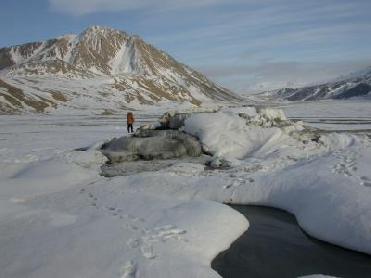
This is Lost Hammer Spring on Axel Heiberg Island, Nunavut Territory, Canada. Photo: Dept. Natural Resource Sciences, McGill University, Montreal.
NEW DELHI (BNS): Researchers studying a Martian-like condition on Earth have discovered that methane-eating bacteria survive in the Lost Hammer Spring located on Axel Heiberg Island in Canada's extreme north.
The unique Lost Hammer spring supports microbial life. The spring is similar to possible past or present springs on Mars, and therefore they too could support life, said McGill University microbiologist Dr. Lyle Whyte.
The subzero water is so salty that it doesn't freeze despite the cold, and it has no consumable oxygen in it. There are, however, big bubbles of methane that come to the surface, which had provoked the researchers' curiosity as to whether the gas was being produced geologically or biologically and whether anything could survive in this extreme hypersaline subzero environment. The research was published in the International Society for Microbial Ecology Journal.
"We were surprised that we did not find methanogenic bacteria that produce methane at Lost Hammer," Whyte said, "but we did find other very unique anaerobic organisms � organisms that survive by essentially eating methane and probably breathing sulfate instead of oxygen."
Recently it was discovered that there is methane and frozen water on Mars. Photos taken by the Mars Orbiter show the formation of new gullies, but no one knows what is forming them. One answer is that there could be that there are springs like Lost Hammer on Mars.
"The point of the research is that it doesn't matter where the methane is coming from," Whyte explained. "If you have a situation where you have very cold salty water, it could potentially support a microbial community, even in that extreme harsh environment."
While Axel Heiberg is already an inhospitable place, the Lost Hammer spring is even more so. "There are places on Mars where the temperature reaches relatively warm -10 to 0 degrees and perhaps even above 0�C," Whyte said, "and on Axel Heiberg it gets down to -50, easy.
The Lost Hammer spring is the most extreme subzero and salty environment we've found. This site also provides a model of how a methane seep could form in a frozen world like Mars, providing a potential mechanism for the recently discovered Martian methane plumes."
Researchers at McGill's department of natural resources, the National Research Council of Canada, the University of Toronto and the SETI Institute carried out the study.
 Previous Article
Previous Article Next Article
Next Article













The Indian Air Force, in its flight trials evaluation report submitted before the Defence Ministry l..
view articleAn insight into the Medium Multi-Role Combat Aircraft competition...
view articleSky enthusiasts can now spot the International Space Station (ISS) commanded by Indian-American astr..
view article